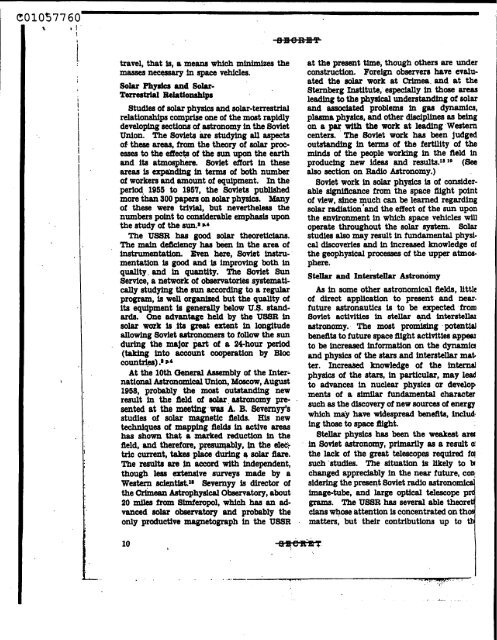4 - The Black Vault
4 - The Black Vault
4 - The Black Vault
You also want an ePaper? Increase the reach of your titles
YUMPU automatically turns print PDFs into web optimized ePapers that Google loves.
C01057760<br />
1 8 1<br />
!<br />
I<br />
!.<br />
I<br />
I '<br />
travel, that is, a meam which minimha the<br />
masses necessary in space vehicles.<br />
solar pnsrios and solar-<br />
Terrestrial Relationahips<br />
Studies of solar physia and solar-terrestrial<br />
relationships comprise one of the most rapidly<br />
developing sections of astronomy in the Soviet<br />
Union. <strong>The</strong> Soviet8 are studying all aspects<br />
of these area8, from the theory of solar processes<br />
to the elTectg of the sun upon the earth<br />
and its atmosphere. Soviet efzort in these<br />
areas is expahding in terms of both number<br />
oi workers and amount of equipment. In the<br />
period, 1955 to 1857, the Soviets published<br />
more than 900 papers on solar physics. Many<br />
of these were trivial, but nevertheless the<br />
numbers point to considerable emphasis u p<br />
the study of the sun.* k4<br />
<strong>The</strong> USSR has good solar theoreticians.<br />
<strong>The</strong> main deficiency has been in the area of<br />
instrumentation. Even here, Soviet instrumentation<br />
is good and is improving both in<br />
quality and in quantity. <strong>The</strong> Soviet Sun<br />
Service, a network of observatories systematically<br />
studying the 8un according to a regular<br />
program, is well 0r-d but the quality of<br />
its equipment is generally below U.S. standards.<br />
One advantage held by the USSR in<br />
solar work is it8 great extent in longitude<br />
allowing Soviet astronomers to follow the sun<br />
during the major part of a 24-hour period<br />
(taking into (uxount cooperstian by Bloc<br />
c0untri.m) .a D.4<br />
At the 10th C%neral Assembly of the International<br />
Astronomical Union, Moscow, August<br />
1958, probably the most outstanding new<br />
result in the field of solar astronomy presented<br />
at the mew was A. B. Severnyy's<br />
studies of solar magnetic fields. Hia new<br />
techniques of mapping flelds in active areas<br />
has shown that a marked reduction in the<br />
fleld, and therefore, pnmqably, @ the &ec;<br />
tric current, takea place during a solar flare.<br />
<strong>The</strong> results are In accord with independent,<br />
though lea8 extensive surveys made by a<br />
Western ecimti6t.u bvernyy is director of<br />
the Crimean Astrophysical Observatory, about<br />
20 miles from Simferopol, which has an advanced<br />
8olar observatory and probably the<br />
only productive magnetograph in the USSR<br />
at the present time, though others are under<br />
construction. Foreign observers have evaluated<br />
the soiar work at Crimes. and at the<br />
Sternberg Institute, especially in those areas<br />
leading to the physical understanding of solar<br />
and associated problems in gas dynamics,<br />
plasma physics, and other disciplines aa being<br />
on a par with the work at leading Western<br />
centers. <strong>The</strong> Soviet work ha8 been judged<br />
outstanding in terme of the fertility of the<br />
minds of the people working in the field in<br />
producing new ideas and results.181e (See<br />
also section on Radio Astronomy.)<br />
Soviet work in solar physics is of considerable<br />
dpifkance from the space flight point<br />
of view, since much can be learned regarding<br />
solar radiation and the effect of the sun upon<br />
the environment in which space vehicles will<br />
operate throughout the solar system. Solar<br />
studies also may result in fundamental physical<br />
discoveries and in increased knowledge of<br />
the geophysical processes of the upper atmos-<br />
Ph-.<br />
Stellar and Interatellrv Astronomy<br />
As in some other astronomical fields, little<br />
of direct application to present and near.<br />
future astronautics is to be expected from<br />
Soviet 8CtiVitkS<br />
vd hkr8klbI<br />
astronomy. <strong>The</strong> most promising potential<br />
benefits to future space flight activities appear<br />
to be increased information on the dynamics<br />
and physics of the star8 and interstellar mat<br />
ter. Increased knowledge of the internal<br />
physics of the stars, in particular, may lead<br />
to advances in nuclear physics or develop<br />
ments of a similar fundamental character<br />
such a8 the discovery of new source8 of energy<br />
which may have widespread benefits, includm<br />
ing those to space met.<br />
Stellar physic8 has been the weakest am<br />
in Soviet astronopy, primarily as a result a:<br />
the lack of the great telescopes required fq<br />
such'studies. <strong>The</strong> situation ls likely to In<br />
changed appreciably in the near future, ca<br />
sidering the present Soviet radio asfronomica<br />
imagetube, and large optical telescope pr<br />
grams. <strong>The</strong> USSR has several able theorel<br />
cian8 whose attention is concentrated on tho;<br />
matters, but their contributions up to tl<br />
10<br />
. . . .-.-<br />
. .."<br />
1'<br />
> I... .

















